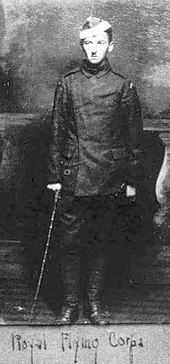Royal Flying Corps Canada
| Royal Flying Corps Canada | |
|---|---|
 | |
| Active | 1917 – April 1, 1918 (as RFCC) April 1, 1918 - 1919 (as RAF(C)) |
| Country | Canada |
| Allegiance | United Kingdom |
| Type | Air force |
| Role | Military Aviation Training |
| Engagements | World War I |
| Commanders | |
| General Officer Commanding | Brigadier-General Cuthbert Hoare |
| Aircraft flown | |
| Trainer | Curtiss JN-4 (Can) |
The Royal Flying Corps Canada (RFC Canada) was a training organization of the British Royal Flying Corps located in Canada during the First World War. It began operating in 1917.
Background[edit]



As the war progressed, Great Britain found that it needed more trained aircrew and more training facilities. Training was provided both by the Curtiss Aviation School at Long Branch near Toronto (land plane training) and Hanlan's Point on Toronto Island (for flying boat training), and in the United States.
The British realized that thousands of Canadians and Americans had joined British flying operations and more wanted to join, so it made sense to open British air training stations in Canada. Canada also had space for such facilities. After much negotiation with the Canadian government, the RFC, commanded in Canada by Lieutenant-Colonel (later Brigadier-General) Cuthbert Hoare, began operating several training stations in southern Ontario.
Training[edit]
Stations were opened at Camp Borden (main training site), Beamsville, Hamilton (armament school), North Toronto (Armour Heights (School of Special Flying), Leaside and Long Branch), and Deseronto (Mohawk and Rathburn). Cadet Officer courses were run at the University of Toronto.
The JN-4 (Canadian) (Canuck) was used for training; 500 Avro 504Ks had been ordered but only one had been completed in Canada before the war ended in November 1918 and it was not used.
Canadian-American Training[edit]
General Hoare made several agreements[2] with U.S. Brigadier-General George O. Squier (US Army Signal Corps) and the US Aircraft Production Board. Squier had overall responsibility for the US Army’s air service, which was short of flight instructors. The RFC released five experienced American pilots to the US Army, where they became squadron commanders. The US Air Board acquiesced in the British opening a recruiting office in New York City, ostensibly to recruit British citizens, but it also solicited US citizens, of whom about 300 were successfully signed up.
The RFCC would also train many US Army flight personnel: 400 pilots; 2,000 ground-crew members; and 20 equipment officers. These Americans would then collect aircraft and equipment from the UK, before coming under RFC control in France. Ten American squadrons would train in Canada during the summer of 1917, while RFCC squadrons were allowed to train during the winter in Fort Worth, Texas, providing training not only for the Canadians but also for the relatively inexperienced American pilots.
End of the war[edit]
When the Royal Flying Corps became the Royal Air Force in April 1918, the unit became known as Royal Air Force Canada (RAF(C)).[3]
During the last two years of the war 3,135 pilots and 137 observers trained in Canada and Texas for both the RFC and the new Royal Air Force (RAF). Of these trainees, 2,624 went to Europe for operational duty.[4]
The RAF(C) was succeeded by the establishment of the Canadian Air Force in 1920 which became the Royal Canadian Air Force on April 1, 1924.
Notes[edit]
- ^ Williamson, Joel. William Faulkner and Southern History. Oxford University Press. 1993. p. 180 Retrieved May 8, 2017
- ^ Cox, Sebastian (Winter 2004). "Aspects of Anglo-US Co-operation in the Air in the First World War". Air & Space Power Journal. Retrieved 5 February 2015.
- ^ Hicks, Don. A History of Air Services in Canada. Retrieved 6 May 2017
- ^ Roberts (1959), p. 9.
References[edit]
- Hunt, C. W. (2009). Dancing in the Sky: The Royal Flying Corps in Canada. Toronto, Ontario; Tonawanda, New York: Dundurn Press. ISBN 9781550028645.
- Morton, Desmond; Granatstein, J. L. (1989). Marching to Armageddon - Canadians and the Great War 1914–1919. Lester & Orpen Dennys Ltd. ISBN 0-88619-209-9.
- Roberts, Leslie (1959). There Shall Be Wings. Toronto: Clark, Irwin and Co. Ltd.
- Nicks, Don (2015). "A History of the Air Services in Canada". Canadian Military Aircraft.
- "Training in Toronto". Alberta's Aviation Heritage. 2004. Archived from the original on 8 December 2010.
External links[edit]
- Halliday, Hugh A.; Brandon, Laura (1999). "Into the Blue, Pilot Training in Canada, 1917–1918" (PDF). Canadian Military History. 8 (1): 59–64.
- Sullivan, Alan (1919). Aviation in Canada, 1917-1918: Being a brief account of the work of the Royal Air Force, Canada, the Aviation Department of the Imperial Munitions Board, and the Canadian Aeroplanes Limited. Toronto.
{{cite book}}: CS1 maint: location missing publisher (link)
